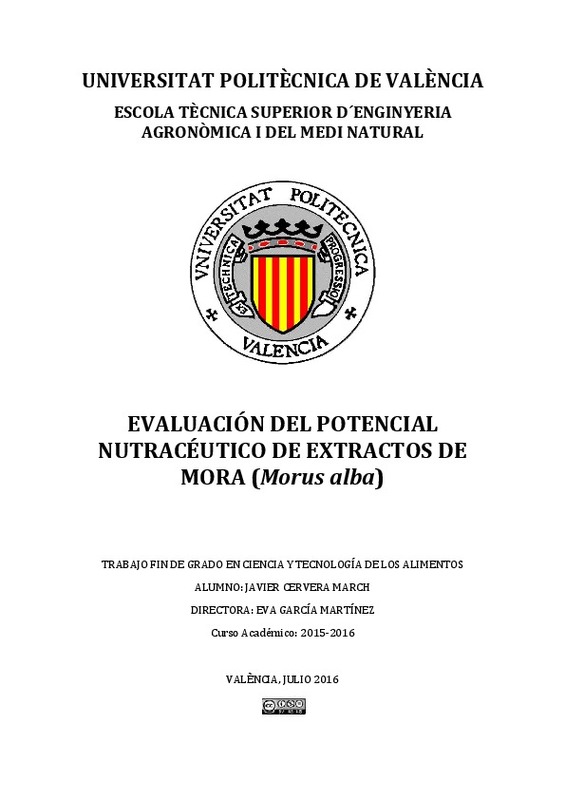|
Resumen:
|
[ES] Las costumbres en la alimentación de los últimos años muestran un interés del consumidor por ciertos alimentos que, además de su propio valor nutritivo, también ayuden a mantener el estado general de salud del organismo, ...[+]
[ES] Las costumbres en la alimentación de los últimos años muestran un interés del consumidor por ciertos alimentos que, además de su propio valor nutritivo, también ayuden a mantener el estado general de salud del organismo, y a su vez puedan tener un efecto adicional de prevención y el tratamiento de enfermedades relacionadas con el daño oxidativo. Esto ha generado una nueva área de desarrollo de productos en la nutrición conocida como nutracéuticos. Los nutracéuticos pueden definirse como suplementos dietéticos concentrados elaborados a partir de sustancias bioactivas naturales derivadas de un alimento que aportan un beneficio para la salud. Se pueden encontrar comercializados en forma de cápsulas, jarabes, polvo, etc. La mora contiene gran cantidad de compuestos fitoquímicos que contribuyen a sus propiedades nutricionales y funcionales. Su extracción puede permitir su empleo como nutracéuticos o como nuevos ingredientes para la fortificación y formulación de otros alimentos, aumentando así su potencial antioxidante, y con ello los beneficios para la salud del consumidor. En este trabajo se obtendrán extractos de mora ricos en compuestos bioactivos hidrofílicos y lipofílicos y se estudiará principalmente el contenido en compuestos fenólicos y carotenoides como principales compuestos bioactivos presentes en esta fruta. Tras su caracterización se evaluará la contribución de estos compuestos a la actividad antioxidante total del producto. Además se estudiará el efecto del proceso de obtención del extracto en la estabilidad del mismo.
[-]
[EN] An adequate and varied diet is important since numerous studies and
recommendations relate a balanced diet with a healthier lifestyle and disease prevention. In
this sense, fruits play a role because they have large ...[+]
[EN] An adequate and varied diet is important since numerous studies and
recommendations relate a balanced diet with a healthier lifestyle and disease prevention. In
this sense, fruits play a role because they have large amounts of antioxidant compounds,
which are related to the prevention of significant pathologies. Mulberry belongs to the so
called family of "forest fruits". This fruit has a long tradition in Chinese culture for its medicinal
properties due to its high content of phytochemicals. However, its production is seasonal and
its stability is very limited, only a small percentage of mulberries reaches the fresh market,
most are frozen or canned. Therefore, it would be interesting to design a nutraceutical from
mulberry extracts, for which freeze dried mulberry may be appropriated. However, the
viability and stability of the nutraceutical depends on many factors, since the bioactive
compounds may undergo different degradation reactions such as oxidation. The aim of this
work was to study the application of freeze drying technology and gum arabic addition as
encapsulant in the bioactive composition and antioxidant activity of mulberry extracts. To this
purpose different extractions were performed with different solvents, in order to obtain a
product rich in water-soluble (phenolics and vitamin C) and liposoluble (carotenoids)
compounds. Furthermore antioxidant activity of the extracts was evaluated by DPPH, FRAP
and ABTS methods. These extracts were dried and the influence of the process was assessed in
the same parameters analyzed in extracts in solution. It has been found that freeze drying
increased the extraction yield of phenolic compounds and carotenoids, but decreased the
content of vitamin C and the antioxidant activity of the extracts. The antioxidant activity
evaluated in the hydrophilic extracts was greater than in the lipophilic one. Vitamin C was the
bioactive that better correlated with antioxidant capacity. Extract dehydration step decreased
phenolic compounds 4% and vitamin C 9%. In general, the addition of gum arabic favoured the
stability of the phytochemicals studied.
[-]
|







